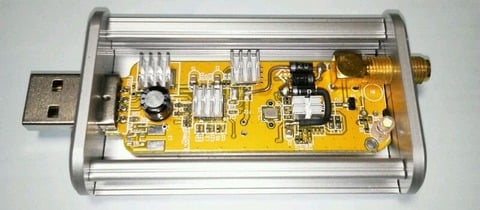Cooling the RTL-SDR for Improved Sensitivity
Over on his blog, Nobu an RTL-SDR experimenter has made a post about cooling RTL-SDR dongles (post is in Japanese use Google translate if needed). Nobu writes that another RTL-SDR experimenter, Toshi, has previously pointed out that an increase in heat appears to reduce the sensitivity of the RTL-SDR.
From his measurements, Nobu found that the internal temperature of the RTL-SDR can reach up to 70 degrees Celsius. So in order to cool the RTL-SDR Nobu has tried two methods. One involving using small cooling fans, and the other involving adding heat sinks to all heat producing components. It seems from the translation that he writes that the improved heat dissipation has extended his ADS-B reception slightly.
If you are interested, Nobu also has a previous post where he also mentions cooling of the RTL-SDR.


Hi, currently trying to source a second module as have some additional hacks to the eeprom that boost high frequency performance. Also relevant: changing the crystal on a recent Bluetooth dongle makes a great micro-beacon for bird (eg homing pigeon) tracking! Seems they can be lowered by up to 5.5 MHz allowing an off the shelf SDR to track it but needs a micro for activation of radio etc. For further tuning penning the crystal also works but finicky as hell.
They turned up! STK0160007052
I will try and post a write-up as its an interesting project for amateur SETI and also the modules literally cost like $8 apiece.
My other project is to supercool a Pi Zero W’s BCM just to see how overclocked I can get it 🙂
Yes, *2 is basically correct. However my IR thermometer seems to show the top of the chip getting hotter.
I wonder if some sort of miniature Peltier module ie the 15*15mm ones (3A 0.7V max) would work?
It wouldn’t need to have that much power though and for this use a simple metal casing would be enough with no fan (probably) needed.
I wonder whether a dongle would work at much lower temperatures, e.g., in liquid nitrogen.
I wonder whether you have in your head cucumbers or potatoes
That’s the best insult you could come up with?
As you may know, in some applications, such as radio astronomy, electronics are often cooled in liquid nitrogen or even liquid helium to greatly reduce noise. It is reasonable to wonder about the lower temperature limits of a dongle, even if we won’t all be acquiring liquid nitrogen tanks.
could put a torrid around the fan’s power lines.
and how aout a small Peltier cooler
The other Question is how much nose the Fan create?
Why not a Full Shielded Case with a “Headpipe” ? I have huge noise on my SDR.
in the second picture i can see a mod , which mod is it ?
Great trick worth trying.
but
1. there’s no need to cool off the EEPROM
2. the back side has much lower thermal resistance to the silicon dice. should place the heatsink the back side.